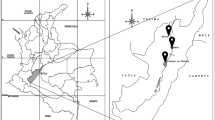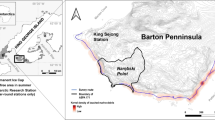Abstract
Microplastics are ubiquitous in the environment. The isolation and characterization of microplastics can change, enabling science to elucidate the fate of microplastics in organisms. The main objective of the present study was to develop a rapid and effective method for the isolation, characterization, and quantification of microplastics from gastropod, and then evaluate the microplastic pollution in wild freshwater snails using the developed method. The whole tissue of gastropod Bellamya aeruginosa was spiked with microplastics derived from cosmetic products to optimize the tissue digestion and microplastic identification process. Optimum digestion of soft tissue was performed using a mixture of Tris-HCl, proteinase K, and KOH. Recovery of microplastics from the tissue digests, as determined by microscopy and infrared spectroscopy, was 89 ± 5%. The entire procedure could be completed within 30 h. Application of the procedure to wild freshwater snail B. aeruginosa collected from Taihu Lake revealed that 90~100% of the sampled snails accumulated 1 to 4 types of microplastics including poly(vinyl acetate), polyethylene terephthalate, polystyrene, and polyamides. In summary, a quick method was developed for the isolation and identification of microplastics from gastropod tissues, and the application of the method revealed the presence of microplastics in snails inhabiting Taihu Lake, China.






Similar content being viewed by others
References
Andrady AL (2011) Microplastics in the marine environment. Mar Pollut Bull 62:1596–1605
Avio CG, Gorbi S, Regoli F (2015) Experimental development of a new protocol for extraction and characterization of microplastics in fish tissues: first observations in commercial species from Adriatic Sea. Mar Environ Res 111:18–26
Barboza LGA, Gimenez BCG (2015) Microplastics in the marine environment: current trends and future perspectives. Mar Pollut Bull 97:5–12
Browne M, Dissanayake W, Galloway T et al (2008) Ingested microscopic plastic translocates to the circulatory system of the mussel, Mytilus edulis (L). Environ Sci Technol 42:5026–5031
Catarino AI, Thompson R, Sanderson W, Henry TB (2016) Development and optimization of a standard method for extraction of microplastics in mussels by enzyme digestion of soft tissues. Environ Toxicol Chem 36(4):947–951
Cho Y, Shim WJ, Jang M, Han GM, Hong SH (2019) Abundance and characteristics of microplastics in market bivalves from South Korea. Environ Pollut 245:1107–1116
Claessens M, Van Cauwenberghe L, Vandegehuchte MB et al (2013) New techniques for the detection of microplastics in sediments and field collected organisms. Mar Pollut Bull 70:227–233
Cole M, Webb H, Lindeque PK et al (2014) Isolation of microplastics in biota-rich seawater samples and marine organisms. Sci Rep 4:4528
Collard F, Gilbert B, Eppe G, Parmentier E, Das K (2015) Detection of anthropogenic particles in fish stomachs: an isolation method adapted to identification by Raman spectroscopy. Arch Environ Contam Toxicol 69:331–339
De Witte B, Devriese L, BeKaert K et al (2014) Quality assessment of the blue mussel (Mytilus edulis): comparison between commercial and wild types. Mar Pollut Bull 85:146–155
Deng YF, Zhang Y, Lemos B et al (2016) Tissue accumulation of microplastics in mice and biomarker responses suggest widespread health risks of exposure. Sci Report 7:46687
Devriese LI, Van der Meulen MD, Maes T et al (2015) Microplastic contamination in brown shrimp (Crangon crangon, Linnaeus 1758) from coastal waters of the southern North Sea and channel area. Mar Pollut Bull 98:179–187
Ding J, Li J, Sun C et al (2019) Detection of microplastics in local marine organisms using a multi-technology system. Anal Methods 11:78–87
Enders K, Lenz R, Beer S et al (2017) Extraction of microplastic from biota: recommended acidic digestion destroys common plastic polymers. ICES J Mar Sci 74:326–331
Foekema EM, Gruijter CD, Mergia MT (2013) Plastic in North Sea fish. Environ Sci Technol 47:8818–8824
Hugo ER, Brandebourg TD, Woo JG, Loftus J, Alexander JW, Ben-Jonathan N (2008) Bisphenol a at environmentally relevant doses inhibits adiponectin release from human adipose tissue explants and adipocytes. Environ Health Perspect 116:1642–1647
ICES (2015) ICES Special Request Advice Northeast Atlantic and Arctic Ocean. OSPAR request on development of a common monitoring protocol for plastic particles in fish stomachs and selected shellfish on the basis of existing fish disease surveys. IICES Advice 1:1–6
Koelmans AA, Besseling E, Wegner A (2013) Plastic as a carrier of POPs to aquatic organisms: a model analysis. Environ Sci Technol 47:7812–7820
Lei K, Qiao F, Liu Q, Wei Z, Qi H, Cui S, Yue X, Deng Y, An L (2017a) Microplastics releasing from personal care and cosmetic products in China. Mar Pollut Bull 123:122–126
Lei K, Qiao F, Liu Q et al (2017b) Preliminary evidence for snail deformation from a eutrophic lake. Environ Toxicol Pharmacol 53:219–226
Li J, Yang D, Li L, Jabeen K, Shi H (2015) Microplastics in commercial bivalves from China. Environ Pollut 207:190–195
Lo HKA, Chan KYK (2018) Negative effects of microplastic exposure on growth and development of Crepidula onyx. Environ Pollut 233:588–595
Lusher AL, Welden NA, Sobralc P et al (2017) Sampling, isolating and identifying microplastics ingested by fish and invertebrates. Anal Methods 9:1346–1360
Mathalon A, Hill P (2014) Microplastic fibers in the intertidal ecosystem surrounding Halifax Harbor, Nova Scotia. Mar Pollut Bull 81:69–79
Munno K, Helm PA, Jackson DA et al (2018) Impacts of temperature and selected chemical digestion methods on microplastic particles. Environ Toxicol Chem 37:91–98
NOAA (2013) Marine debris monitoring and assessment: recommendations for monitoring debris trends in the marine environment. Technical Memorandum NOS-OR&R-46
NOAA (2015) Laboratory methods for the analysis of microplastics in the marine environment: recommendations for quantifying synthetic particles in waters and sediments. U.S. Technical Memorandum NOS-OR&R-48
Nuelle MT, Dekiff JH, Remy D, Fries E (2014) A new analytical approach for monitoring microplastics in marine sediments. Environ Pollut 184:161–169
Rochman CM, Manzano C, Hentschel BT, Simonich SL, Hoh E (2013) Polystyrene plastic: a source and sink for polycyclic aromatic hydrocarbons in the marine environment. Environ Sci Technol 47:13976–13984
Rochman CM, Tahir A, Williams SL et al (2015) The anthropogenic debris in seafood: plastic debris and fibers from textiles in fish and bivalves sold for human consumption. Sci Rep 5:14340
Su L, Xue YG, Li LY, Yang D, Kolandhasamy P, Li D, Shi H (2016) Microplastics in Taihu Lake, China. Environ Pollut 216:711–719
Teuten EL, Rowland SJ, Galloway TS, Thompson RC (2007) Potential for plastics to transport hydrophobic contaminants. Environ Sci Technol 41:7759–7764
Thielea CJ, Hudson MD, Russell AE (2019) Evaluation of existing methods to extract microplastics from bivalve tissue: adapted KOH digestion protocol improves filtration at single-digit pore size. Mar Pollut Bull 142:384–393
United Nations Environmental Programme (2016) Marine plastic debris and microplastic technical report. Nairobi
van Cauwenberghe L, Janssen CR (2014) Microplastics in bivalves cultured for human consumption. Environ Pollut 193:65–70
Veerasingam S, Saha M, Suneel V, Vethamony P, Rodrigues AC, Bhattacharyya S, Naik BG (2016) Characteristics, seasonal distribution and surface degradation features of microplastic pellets along the Goa coast, India. Chemosphere 159:496–505
von Moos N, Burkhardt-Holm P, Kohler A (2012) Uptake and effects of microplastics on cells and tissue of the blue mussel Mytilus edulis L. after an experimental exposure. Environ Sci Technol 46:11327–11335
Wang W, Ndungu AW, Li Z, Wang J (2017) Microplastics pollution in inland freshwaters of China: a case study in urban surface waters of Wuhan, China. Sci Total Environ 575:1369–1374
Yang JJ, Xu L, Lu AX et al (2018) Research progress on the sources and toxicology of micro(nano) plastic in environment. Environ Chem 37(3):383–396
Zhang WH, Xu QJ, Wang XX et al (2017) Spatiotemporal distribution of eutrophication in Lake Tai as affected by wind. Water 9:200
Funding
This work was supported by the National Natural Science Foundation of China (41673122 & 21577137) and Beijing Natural Science Foundation (8162041).
Author information
Authors and Affiliations
Corresponding author
Additional information
Resposible Editor: Philippe Garrigues
Publisher’s note
Springer Nature remains neutral with regard to jurisdictional claims in published maps and institutional affiliations.
Rights and permissions
About this article
Cite this article
Xu, Q., Deng, T., LeBlanc, G.A. et al. An effective method for evaluation of microplastic contaminant in gastropod from Taihu Lake, China. Environ Sci Pollut Res 27, 22878–22887 (2020). https://doi.org/10.1007/s11356-020-08747-8
Received:
Accepted:
Published:
Issue Date:
DOI: https://doi.org/10.1007/s11356-020-08747-8




